[ Presentation ] [ Script ] [ Bernard Deyriès and Jean Chalopin ]
[ Staff ] [ Dubbing ] [ Haïm Saban, Shuki Levy and Noam Kaniel ]
[ Scott O'Dell: The King's fifth ] [ Celluloids ] [ Conan ]
The world of celluloids is quite complex, and behind what could be considered as simple drawings hides a whole mechanic whose only purpose is to make quality animes.
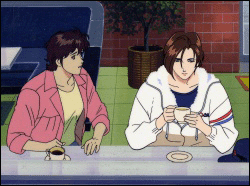
Have you ever wondered, "But how is a cartoon done?" To the answer to this simple question, there is a word: celluloid. Talking about celluloid or animation is almost the same, as you generally need the first one to create the second one ...
A celluloid, what is it? Everyone has heard more or less about it, but what about? How are they made and how are they used, how much can we have in an episode or in a movie, are they all of the same size, or how much is it worth? Many questions that DVDAnime will try to answer ...
To illustrate this issue, I will base myself on a celluloid from City Hunter: Goodbye My Sweetheart, from the scene between Kaori and Emi in the "Cat's Eye" coffe (at 9'30").
What is a celluloid?
A celluloid, also often called 'cellulo' (which I will use later), or 'cell', is above all the transparent plastic sheet on which will be drawn the characters, or decorative elements. Most of the time (for the series), it is a sheet in the format a bit equivalent to the A4 (26,5 x 23), with 3 holes at the top, but there are other formats, larger by example, for movies or horizontal scrolling sequences, or higher, for standing characters or vertical scrolling.
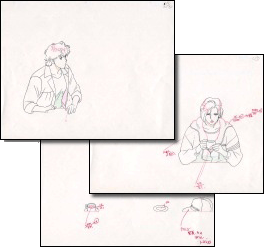
It is therefore on this medium that we will paint (as it is painting) our various heroes. But before reaching this stage, we will first prepare the drawing on a simple sheet (called 'sketch' in general), with the same format, and with the same holes at the top. This sketch actually shows the outlines of the character we are going to draw, with the areas of light and shadow, and some annotations for the colors to use. It's a bit like a drawing to color ...
This sketch will then serve as a basis for the future cellulo: it passes through a device that will reproduce on the cellulo all the black lines on the back. This cellulo is then placed above the sketch (the holes at the top are used to align the 2 sheets, with the appropriate device) in order to reproduce other secondary features, such as the color separations (shadow / light on the skin or clothes).
Then we remove the sketch and we will apply the colors at the back of the cellulo. Why on this side? Because the paint will always have a very smooth appearance when we look at the cellulo front since it is glued to the support. This also has the advantage that if some colors overflow on others, it won't be visible as it is on the back. All colors are thus put one after the other, first the details and then large colored areas. In addition to some features on the front, we can also add some effects of reflections for example. It would be too difficult to draw them on the back first, before the characters. This gives a simple image on a transparent background that can be used later in one or more animated sequences.
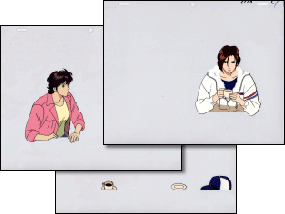
Note that all the cellulos have a code on the top right corner that identifies them. This code will be used later to sort the cels and create the sequences in the right order. For a single cell, it's usually 'A' plus a number. If there are several superimposed cells, they will be numbered 'A', 'B', 'C' plus a number (not necessarily the same). One can also find the word 'End' when it is the last cellulo of a sequence.
One celluloid = one image?
Does 1 celluloid = 1 image? Well, the example above from City Hunter already answers this question: no, of course. In reality, many scenes require that we do not draw everything on a single cellulo: several characters will each have their own cellulo, or for a single character, we can leave "empty" areas. This is the case of a close-up face that speaks for example. Indeed, the complete face will not be on a single cellulo, but on several: the face without the mouth on one side, and the mouth alone on the other. In our example of City Hunter, this is the case of Kaori: the mouth is dissociated from her face because she speaks at this moment. Thus the different lip movements can be drawn on several cellulos apart, and the face will be reused as many times as necessary. The cellulos being transparent, we just have to superimpose them to obtain a complete image. This has two major advantages: saving precious time, and especially a fixed face that does not move at all. If one had had to redraw the face several times, it would be impossible to have exactly the same details at the same place, and one would feel, during the animation, a kind of unpleasant trembling.
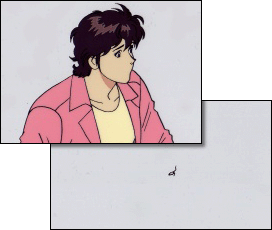
Thus a celluloid can be used for several images, and conversely, to obtain a single image, several celluloids can be used. Note that generally, even for a small detail on a cellulo, the corresponding sketch was drawn before. Thus, if for a scene we have 4 cellulos, we first drawn the 4 corresponding sketches.
What about the backgrounds?
For the backgrounds, things are generally much easier: it is a sheet of paper, on which one paints the desired decoration: the interior of a room, a forest, buildings, etc. A background is often very neat and can have a multitude of small details and quite varied effects, since there will be no animation to be done at this level. Be careful however, this does not mean that all the decorations are drawn that way: they can also be drawn on celluloid, for example the decorations that will be modified like a wall that is destroyed or rocks that burst, or moving elements like trees in the foreground during a scrolling. Here we have elements that are "animated" just like a character. This is easily noticeable when you watch a cartoon, because this kind of element is often in the foreground, with less detail and colors more vivid than the "real" background, which is meticulousness drawn.

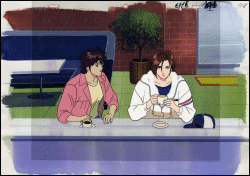
Once this step is over, all you have to do is position the cell(s) over it, and you have a complete image that can be "scanned" for the creation of the animated cartoon. Of course, there is much less sceneries that cellulos to achieve: a single background can be used for several seconds (or minutes). When you are looking for cellulos, most of them are without background.
The final image
Once we have the background and various cellulos, we use a machine that will photograph one by one all the combinations (cellulos + background) to get what we will see on the screen. It is a rather tedious job, usually done by a director of photography (and his team). At this step, some luminous effects (sun rays, or for example the cosmo energy of the Knights of the Zodiac) are realized. You may also notice on the images presented above that the edges of the decor or cells were not perfect. In fact, only about 2/3 of the surface is actually used. Once all the images are scanned, they are subsequently used to create the animations themselves, but this is another (technical) subject that I will not discuss here. For animated sequences, one generally uses a sheet on which the required cells are listed (time chart).
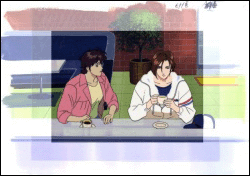
How many celluloids?
Interesting question among many others, we must first differentiate a simple television series on one side, and animated films on the other side. It is obvious that if we decide to animate more elements, or to have more images per second, then the final animation will be obviously better. For a TV series, there are fewer frames per second in general than in a movie, and there are much more fixed scenes, which also limits the number of cellulos to create and is clerly visible.
How much does it cost for collectors?
The question that will hurt your wallet ... Indeed, once a series or film is over, many celluloids are on sale, mainly in specialty shops, and many fans hope to get a real "unique" piece of their favorite series. Indeed, remember that a celluloid is unique which is obviously important, because unique can mean very expensive! Then a lot of criteria should be considered: is it a popular series or not? Is there a background? The sketch? Many combinations are possible. Most of the time, you will find simple cellulos without background, with quite often the sketch that goes with it. You will more rarely find a cellulo with its background (logical, since only one background is used for several cellulos), but it's more expensive. And if you are lucky, you can find the cellulo-sketch-background trio. But that's a lot rarer.
So how much is it cost? Less than 10 euros for the cheapest. In general it is a single character, without background, and a not very popular series. But most of them will cost between 50 and 150 euros. At this price, you will find more well-known characters with backgrounds, such as City Hunter, Cobra or a Saint Seiya. But it can be much more expansive! A close-up with a main character, with a beautiful background, from a popular series, can easily reach several hundred euros. Finally, if you look for cellulos from Ghibli studio for example, ask a loan to your banker: I personally saw some cellulos costing more than 10 000 euros!
Finally, note that on many recent series, with the new animation techniques (computer, ...) less cellulos or backgrounds are made (all the mechas are created entirely by computer). So, these cellulos are also more expensive, since there are rarer.
For the question of finding them, there are some dedicated shops, and you will also find some cells at major conventions (Japan Expo, Cartoonist in France). Otherwise many sites on the internet sell some cells, but it is better to see a real cellulo before buying, at least to check if it is not damaged (or stuck to the background, what often happens after a long time), something difficult to check on the internet. Finally, the best thing is to know someone in Japan, the prices being much lower there than in France.
Are there fake ones?
Unfortunately, yes. However it is very rare, but that it particularly true with large cells, which are expensive. Indeed, a fake cellulo that is only 40 or 50 euros is not profitable. This also mainly concerns single cellulos without background, and of course, without sketch. However, it is very difficult to spot a fake, especially for a recent series, but as long know reliable shops or websites, there should be no problem. Among thousands of real cellulos sold, buying a fake one is extremely rare.
Also beware of the combination background + cellulo, where sometimes the background has absolutely nothing to do with the cell! I once saw a cell from Lady Oscar with a pyramid behind her! However if the background is not the good one, it can still be part of the series. As the background are not directly related to a single cellulo, it happens that they are mixed afterwards, once the series is finished ...
Finally, just know that there are also true-false cellulos. I know, it's strange. It is actually several copies of the same cell, scanned directly by the production studios, to compensate for the lack of cellulos for recent series, or because the original cellulos were never available to the public. This is the case for Evangelion in particular, where the Gainax studio treasured most of its drawings. However, this is a very rare practice ...
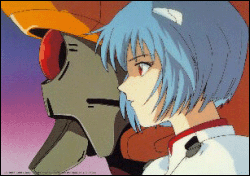
Conclusion
As you can see, the world of celluloids is finally quite complex, and behind what could be considered as simple drawings, there is a whole mechanic whose only purpose is to make animation of quality. Today, the new techniques tend to simplify the general work and many drawings (characters or decorations) are made with a computer, but celluloids are still used a lot, offering a final rendering often different from what we obtains with a computer.
[ Next ]
[ Presentation ] [ Script ] [ Bernard Deyriès and Jean Chalopin ]
[ Staff ] [ Dubbing ] [ Haïm Saban, Shuki Levy and Noam Kaniel ]
[ Scott O'Dell: The King's fifth ] [ Celluloids ] [ Conan ]



